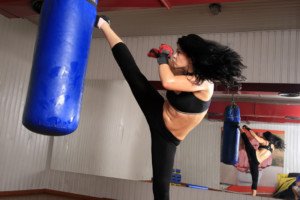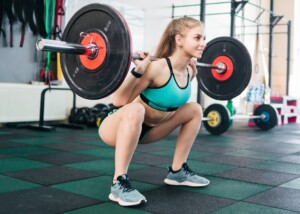
If you’re a woman who’s mad that your long femurs make squatting difficult, here’s a reason to embrace those generous thigh bones!
Are you a woman who’s been struggling to pull off a decent squat at the gym, and have realized that the obstacle is your relatively long femurs? I’m a certified personal trainer and have years of martial arts training.
From a biomechanical perspective, relatively long femurs will literally get in the way of a depth squat if you want a decently upright back, and will also make parallel squatting difficult without leaning way forward (unless you use a wide-enough stance).
I have good news for women who tell people, “My squat sucks because of my long femurs.”
The good news is that, while long femurs (meaning, they are lengthier than your torso, regardless of overall body height), are a biomechanical disadvantage in the squat, particularly the back squat, they are a blessing for kicking.
To prepare for kicking, the leg needs to chamber, driven by hip action. Imagine which would generate greater power (especially in a rotational kick like the roundhouse), since the femur is the driving force: long femur chambering from the hip, with little drag from a short tibia, or short femur with all the drag from a long tibia.
Another way to look at this is to imagine a two-foot long plank of wood (this part represents the long femur) with a one-foot long skinner plank (representing the short tibia) attached to its end that can swing about. You whack this contraption as hard as possible into a heavy bag.
Now, take the same device except that the first part of the instrument is only one-foot long (representing the short femur), and the second, thinner portion is two-feet long (long tibia).
Hold the short portion and whack the device into a heavy bag.
Which device generated more power? The first one, of course! Though the longer board with shorter attachment has a greater range of motion as far as extension of angle, than does the shorter board with the lengthier attachment, it also delivers more power.
I was recently viewing an MMA fight online. A man was knocked out cold by a high knee kick to the face.
It’s easy to imagine how much easier it would be to deliver this kind of kick if you had a generous thigh bone.
The guy with short femurs would have to work harder to get his knee up there, if he could even reach his opponent’s face at all.
Women and Kicking
Speaking of knee kicks, I doubt any man would want to be kneed in the groin by a knee that’s driven by a long femur versus short thigh.
Women can think of their long femurs as very nasty weapons in a self-defense situation.
Another great kick for women is the roundhouse knee kick. Visualize this kick going at a heavy bag if you’re familiar with this kick, and then visualize it being done with short and long thighs. I needn’t say more.
Women must train faithfully to develop reliable self-defense skills. If a woman delivers a haphazard street kick, femur length won’t matter.
Long femurs are an advantage in the following basic full-leg kicks: front, side, round, hook and axe; and in all knee strikes.
 Lorra Garrick is a former personal trainer certified through the American Council on Exercise. At Bally Total Fitness she trained women and men of all ages for fat loss, muscle building, fitness and improved health.
Lorra Garrick is a former personal trainer certified through the American Council on Exercise. At Bally Total Fitness she trained women and men of all ages for fat loss, muscle building, fitness and improved health.
.


























